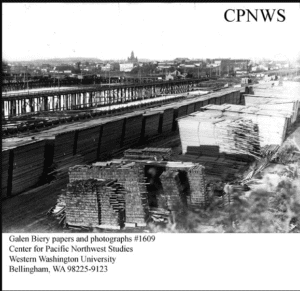Get familiar with a cleanup site along Bellingham’s waterfront that is contaminated from past operations treating pulp and paper at the GP West Lignin Parcel site. You can have a say in how the Washington State Department of Ecology might address the contaminants!
RSVP for an in-person tour on Wednesday, June 29th from 12:00–1:30 p.m. Ecology staff will also have a presentation that evening ay 6:30 p.m. at their office at 913 Squalicum Way, Unit 101, Bellingham WA.
The Lignin Parcel which is a 3 acre piece of land that is a part of the greater 74 acre Georgia Pacific cleanup site. This area was used to store and process lignin, a byproduct of the pulp and tissue industry and it was made into a variety of products such as artificial vanilla flavoring, dust retardants, solvents and pharmaceuticals. The industrial practices that occurred here, though, led to contamination of soil and groundwater with heavy metals, polycyclic aromatic hydrocarbons (PAHs) as well as other petroleum byproducts. Thankfully, this area is not contaminated with mercury like other parts of the GP mill site. After the cleanup, it will eventually have affordable housing as well as a YMCA facility. Learn more about the site on Ecology’s page.
Submit a public comment on the site’s cleanup here between June 20th and July 19th, 2022.
We’ve also created a virtual tour below, featuring videos with transcripts and links to learn about the site’s history and issues it faces. It will help you feel more prepared to share your thoughts with Ecology.
See the full transcript of the video tour.
 Background: An industrial history on Whatcom’s waterfronts
Background: An industrial history on Whatcom’s waterfronts
The Bellingham Waterfront was a seat of industrial activity for more than 100 years, an era that ended with the closure of the Georgia-Pacific tissue mill in 2007. Industries left behind a legacy of toxic pollutants in the soil, sediment, and water — including mercury, nickel, dioxins, petroleum byproducts, and more. The shoreline was also physically altered by armoring off beaches, dredging up sediment, and filling in parts of the natural shoreline to build on.
Several other sites, such as GP West’s Lignin Parcel, also have pollution from past use that needs to be cleaned up.
See the Department of Ecology’s map of the 12 contaminated sites in Bellingham Bay and where each one is in the Model Toxics Control Act (MTCA) cleanup process. You can also see what cleanup sites are near you with Ecology’s searchable map tool.
Learn more about the MTCA process!
Until very recently, this industrial development also resulted in the central waterfront area being largely off-limits to the public ever since, despite the fact that the City and Port of Bellingham currently own the land. While it’s easy to feel separated from this legacy, it affects places Whatcom residents know and love. Even local favorite Boulevard Park was home to a coal-fired gas plant that left heavy metals and fossil fuel byproducts.
The toxic contamination and heavily modified shoreline make the waterfront hazardous to young salmon, which need clean, protected, and connected nearshore habitat to grow and make it to the open ocean. The decline of eelgrass beds and gravel beaches which act as nurseries for forage fish (which salmon need to eat) have put an additional stress on our dwindling salmon populations.
Bellingham’s waterfront gives our community a unique opportunity to make something positive from former industrial areas. As we’ve seen from the completed cleanup at Waypoint Park in 2018 — complete with some young salmon habitat, new businesses, and a playground — it can be done.
This material is funded through a Public Participation Grant from the Washington State Department of Ecology. The content was reviewed for grant consistency but is not necessarily endorsed by the agency.
Cover photo by Eric Creitz.

 Background: An industrial history on Whatcom’s waterfronts
Background: An industrial history on Whatcom’s waterfronts